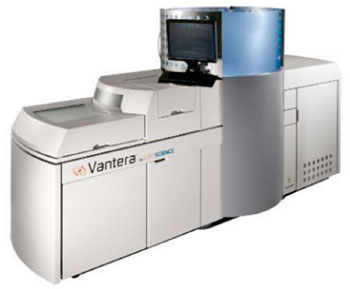LDL Particle Number Measured Using NMR Clinical Analyzer
By LabMedica International staff writers
Posted on 25 Aug 2014
Fully-automated high-throughput nuclear magnetic resonance (NMR) spectroscopy has been developed to enable measurements in a clinical laboratory setting. Posted on 25 Aug 2014
NMR-measured low-density lipoprotein particle number (LDL-P) has been shown to be more strongly associated with cardiovascular disease outcomes than LDL cholesterol (LDL-C) in individuals for whom these alternate measures of LDL are discordant.

Image: The Vantera Clinical Analyzer offers the technology that has the ability to directly enumerate low-density lipoprotein (LDL) particle numbers (Photo courtesy of LipoScience).
Scientists at LipoScience Inc. (Raleigh, NC, USA) purchased serum pools and controls from Solomon Park Research Laboratories (Kirkland, WA, USA). Controls were prepared by identifying serum samples with high and low lipoprotein ranges. Additional serum pools were prepared in-house from donor subjects identified at LipoScience or Mayo Clinic (Rochester, MN, USA). NMR spectra were acquired on the NMR Profiler (Bruker Bio-Spin; Billerica, MA, USA) or the Vantera Clinical Analyzer (Agilent Technologies; Santa Clara, CA, USA), both equipped with 400 MHz 1H NMR spectrometers.
The sensitivity and linearity were established within the range of 300–3,500 nmol/L. For serum pools containing low, medium and high levels of LDL-P, the inter-assay, intra-assay precision and repeatability gave coefficients of variation (CVs) between 2.6 and 5.8%. The reference interval was determined to be 457–2,282 nmol/L and the assay was compatible with multiple specimen collection tubes. Of 30 substances tested, only two exhibited the potential for assay interference. Moreover, the LDL-P results from samples run on two NMR platforms, Vantera Clinical Analyzer and NMR Profiler, showed excellent correlation.
The authors concluded that the successful development of a method to measure LDL-P on a fully automated platform allows NMR technology dissemination into the routine, clinical laboratory setting and creates the opportunity for NMR-based testing across a broader range of clinical applications. They point out that, several leading national reference laboratories and large hospital system laboratories have successfully integrated the Vantera into their clinical laboratory operations. The study was published on July 28, 2014, in the journal Clinical Biochemistry.
Related Links:
LipoScience Inc.
Mayo Clinic
Bruker Bio-Spin












.jpg)
